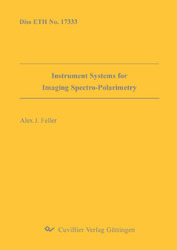| Departments | |
|---|---|
| Book Series (96) |
1377
|
| Nachhaltigkeit |
3
|
| Gesundheitswesen |
1
|
| Humanities |
2361
|
| Natural Sciences |
5403
|
| Mathematics | 229 |
| Informatics | 318 |
| Physics | 979 |
| Chemistry | 1362 |
| Geosciences | 131 |
| Human medicine | 243 |
| Stomatology | 10 |
| Veterinary medicine | 108 |
| Pharmacy | 147 |
| Biology | 835 |
| Biochemistry, molecular biology, gene technology | 121 |
| Biophysics | 25 |
| Domestic and nutritional science | 45 |
| Agricultural science | 1004 |
| Forest science | 201 |
| Horticultural science | 20 |
| Environmental research, ecology and landscape conservation | 148 |
| Engineering |
1788
|
| Common |
97
|
|
Leitlinien Unfallchirurgie
5. Auflage bestellen |
|
Advanced Search
Instrument Systems for Imaging Spectro-Polarimetry (English shop)
Alex J. Feller (Author)Preview
Table of Contents, Datei (93 KB)
Extract, Datei (360 KB)
This thesis is devoted to the development and the application of novel instrument systems and measuring techniques in the field of solar polarimetry. The work is split into three parts, each part addressing an independent project in terms of scientific objectives and implementation.
In the first part I describe the development and implementation of a tunable narrow-band filter system to be used in combination with the Zurich Imaging Polarimeter for quasi-monochromatic imaging vector polarimetry. Its working range covers the visible spectrum between 390 nm and 660 nm. The bandwidth varies between 2 pm and 12 pm, depending on wavelength and optical setup. The main filter components are two lithium-niobate Fabry-Pérot interferometers which can be tuned by applying a voltage or by changing the temperature. In the current version of the instrument the interferometers are used in series in a single-pass tandem configuration. The filter system will allow us to explore the spatial structuring of the polarized solar spectrum, including vector mapping of the Hanle and Zeeman effects in any spectral line. First polarimetric images recorded at the SST and at IRSOL in the spectral lines of Ca I 422.7 nm, Sr I 460.7 nm and Hα 656.3 nm show that the instrumentation and its operation is technically mature. The filter system is now available for scientific observations.
The second part deals with a laboratory experiment linked to a solar polarization anomaly that has remained an unresolved enigma for many years. While scattering processes usually produce polarized radiation, certain spectral lines, in particular the Fraunhofer D1line of neutral sodium at 589.6 nm should be intrinsically unpolarizable according to the standard quantum mechanical scattering theory. In contrast, observations in quiet regions on the Sun reveal a polarization peak centered in the D1 line core. As the solar atmosphere is a complex environment with an optically thick medium permeated by a tangled and fractal-like magnetic field, we have set up a laboratory experiment with a sodium vapor cell to obtain an answer to the question: Is the sodium D1 anomaly a problem for atomic or for solar physics? The experimental results are consistent with the theoretical null prediction of atomic physics. Furthermore the experiment gives an upper limit for the D1 polarization which is smaller than the signal observed on the Sun. Although this result does not provide the definitive answer to the problem, it permits to conclude that the clarification of the D1 anomaly has to involve solar physics.
The third project included in this thesis is the development of a dedicated instrument to capture the polarization of the chromospheric emission spectrum (flash spectrum) during the total solar eclipse of March 29, 2006. The whole visible range and small overlaps with near UV and near IR have been covered with a spectral resolution of 3000. The minimum sampling period was chosen to be 20 ms, which corresponds to a height resolution of some 10 km in the solar atmosphere, along the direction of the lunar movement. The flash spectrum has been successfully recorded during the above-mentioned eclipse in the Sahara desert in southern Libya. For several spectral lines the noise level in the degree of polarization is of order 1% which allows us to compare with theoretical predictions. However, it is tricky to correct for the systematic errors because of optical aberrations in the observed spectra.
| ISBN-13 (Printausgabe) | 3867275548 |
| ISBN-13 (Hard Copy) | 9783867275545 |
| ISBN-13 (eBook) | 9783736925540 |
| Language | English |
| Page Number | 192 |
| Edition | 1 |
| Volume | 0 |
| Publication Place | Göttingen |
| Place of Dissertation | Zürich |
| Publication Date | 2008-04-01 |
| General Categorization | Dissertation |
| Departments |
Physics
|








